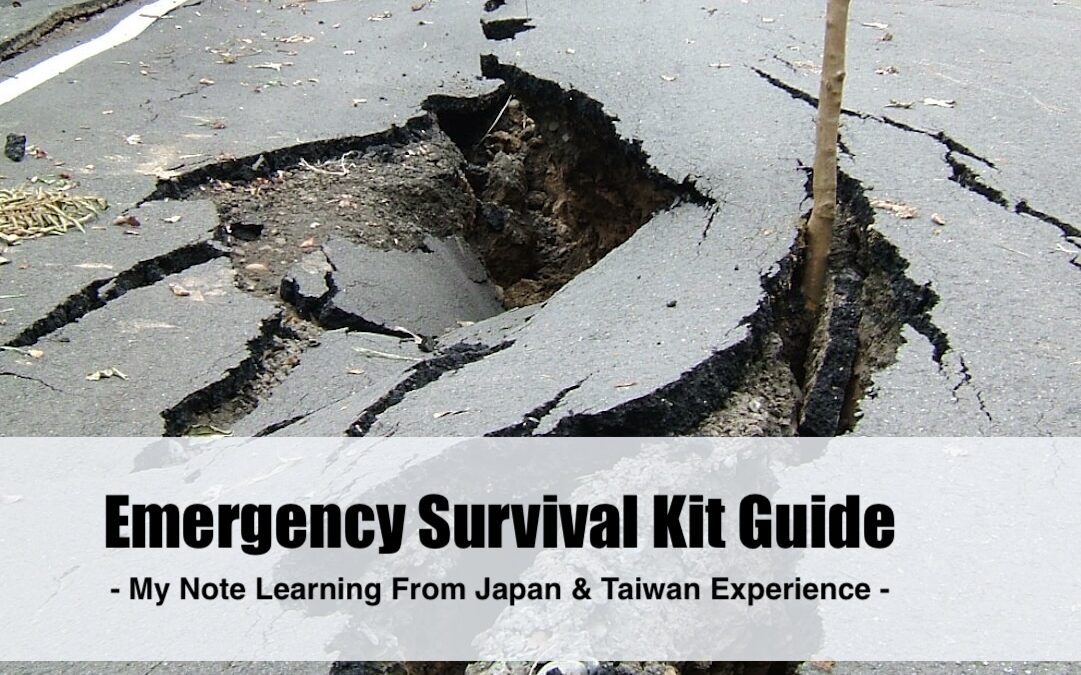After relocation to Japan, we found that Japan has a comprehensive disaster preparedness plan and infrastructure. For instance, the Meguro Ward where we lived last time has its disaster announcement app to broadcast if there are any disaster warnings or information updates like the opening/close of evacuation centres, which is very convenient. As a result, we began to consider preparing a disaster kit at home. The following article is some notes I made about preparing a disaster kit.
1. Why Do We Need An Emergency Survival Kit?
1.1 An emergency kit is to increase your chances of survival AFTER a disaster occurs.
After a disaster, there may be a period of interrupted supplies (such as water, electricity, food, natural gas, etc.), and there may also be an immediate need to go to evacuation centres. If an emergency kit is prepared, it can be useful and increase the chances of survival in emergencies (including remaining healthy).
1.2 One emergency kit per pax if possible (for those who can carry a backpack). The content in the backpack is customised based on the individual’s needs and capacity.
Considering that it is very likely to get separated during the evacuation, it would be great for each person to have his/her customised emergency kit since not everyone is as powerful as Hercules to carry everything. Prioritisation is crucial! For example, water is extremely important so everyone should carry some but I put a little more water in the bag of stronger family members. Lastly, don’t forget the special needs of your family members like elderly people, babies, or pets.
1.3 Check and update the items in the emergency kit REGULARLY.
Food, medication, batteries, and other items in the emergency kit may expire or become ineffective, so it is necessary to regularly check and replace these items. This part can be easily done by using calendar reminder tools when preparing or updating the kit.
1.4 The emergency kit should be stored in a safe and easy-to-access place.
The emergency kit should be placed that is easy to access, while also staying away from potentially dangerous places, such as near flammable materials, next to glass windows, etc. For me, I choose to put the kits inside the cabinet near the entrance.
1.5 Except for kit preparation, it is also important to update related information regularly like the escape routes at home and nearby evacuation locations.
Regular training and drills should be conducted among family members, including earthquake evacuation, first aid procedures, escape routes, and evacuation locations, etc., to ensure that everyone knows how to respond to emergencies. In emergencies, it may not be possible to use phones or the internet, so it is important to prearrange contact methods among family members, such as text messages, walkie-talkies, etc. Keeping calm and rational in emergencies is very important, so make sure that family members know how to respond and follow safety instructions.
2. What To Put In The Emergency Kit?
Below is the list you can consider to prepare in your emergency kit. Again, the individual carrying capacity and needs should be properly considered.
2.1 Emergency food and utensils (for at least 3 days).
- Drinking water (bottled): In Taiwan, at least 1 litre of water per person per day is recommended (Japanese recommends 3 litres of water per day instead). If you can’t carry it, it’s okay to prepare a little less, but it’s better to have at least 2 litres (preparing small bottles is more convenient).
- In addition to the bottled water, if you have the capacity, you can consider packing portable water tanks/bags or filters.
- Instant food: Canned food, instant rice, dry food, or biscuits are welcome. It is best to have food that does not need to be heated or has its own heating function. When preparing your food collections, ensure to include a variety of nutritious like protein, vitamins, and dietary fibre rather than just starch.
- Utensils: Such as bowls, chopsticks, forks, etc.
2.2 First aid kit, personal medications, and hygiene products.
- First aid kit: Including gauze, adhesive bandages, disinfectant, painkillers, antipyretics, etc.
- Personal medications: Especially the medicines you take regularly.
- Hygiene products: Masks, mouthwash or toothbrush wipes, towels or compressed towels, toilet paper, wet wipes, disinfectant alcohol, dry hand sanitiser, plastic gloves, portable toilets, feminine pads, etc. Those products are helpful in keeping you healthy.
- Plastic bags: Not only are they useful for packing things, but if there are occasions where you encounter water (rain, flooding, crossing rivers, etc.), they can also keep the products inside your emergency kit dry.
2.3 Clothing and products to keep you warm.
- Clothing: Warm clothing and underwear.
- Blankets, sleeping bags, raincoats, large pieces of thermal foil.
2.4 Survival and communication-related products
- Flashlights or headlights: Remember to prepare enough batteries or self-chargeable flashlights.
- Radio, disaster evacuation map, compass, paper, and pen: For listening to, recording, and navigating emergency notifications to facilitate reaching safe evacuation locations.
- Whistle: Easy to call for help loudly when you are stuck.
- Thick cotton gloves and slippers: To protect you from sharp objects during movement.
- Batteries, power banks, or chargers: Provide power for communication devices such as mobile phones.
- Multifunctional tools: Such as Swiss knives and scout ropes help you handle various situations.
- Lighter: To start a fire when needed.
- Walkie-talkie: Convenient for family members to contact each other when there is no phone signal.
- Safety helmet or headgear: Protect the head.
2.5 Important document copies and items
- Copies of important documents: Such as ID cards, passports, driver’s licenses, etc.
- Insurance documents: Copies of health insurance, home insurance, etc.
- Phone numbers and addresses of family members and emergency contacts.
- Backup keys.
- A small amount of cash: Because you may not be able to use credit cards or ATMs, it’s best to have some change, you never know when you might need to use a public phone or vending machine.
2.6 Other Special Needs Items
If there are elderly people, babies, pets, or individuals with special needs at home, it is necessary to consider additional special food and supplies for them. The following is a list of some things to consider bringing.
- Elderly people: Ready-to-eat porridge (to prevent dehydration in the elderly), hearing aid batteries, denture cleanser, etc.
- Babies: Baby food (formula, long-life milk, or baby food), diapers, disposable bottles, etc.
- Pets: Pet food and dishes, leashes, pet toilets, etc.
3. Where To Buy Emergency Kits?
The easiest way is to search for “emergency kit” or “防災セット” (Japanese) on e-commerce websites like Amazon Japan. Some sets are supervised by experts which can be ordered directly according to your needs. However, to be honest, buying a complete set directly is usually more expensive. So if you are sure what items you want to prepare, I highly recommend going directly to stores like Daiso, Decathlon, or camping and athletic stores to buy the items you need separately.

In Japan, I highly recommend going to Daiso to prepare your emergency kits. Daiso stores usually have a disaster prevention area with a wide range of products that are cheap and useful. And even if you are not clear what to prepare, you can go to the stores and learn about it. Decathlon is a good place to buy cheap bags or small items like headlights. Camping and athletic stores (especially in Japan) sell many delicious instant foods. By the way, it’s easy to buy food in Japan with a shelf life of five years, but I think as long as you regularly update them, you don’t have to worry too much about expiry dates. After all, normal bottled water is cheaper than bottled water which can keep for 5 years long.
4. Reference
4.1 Taiwan disaster prevention and evacuation related information
- Ministry of the Interior Fire Department, National Disaster Prevention Day – Earthquake Disaster Preparedness Knowledge “Preparation of Emergency Kits“.
- Ministry of the Interior Fire Department, Fire and Disaster Prevention Museum website.
4.2 Japan disaster prevention and evacuation related information
- Tokyo Metropolitan Disaster Information Website, Disaster Knowledge Pamphlet Special Section.
- Fire and Disaster Management Agency, Fire and Disaster Prevention Museum website.
- Ministry of Agriculture, Forestry, and Fisheries, Disaster-related Information.
END.
Emergency Survival Kit Guide
Related posts
About Me
Hi! I am Wang wang, a Taiwanese girl living in Tokyo. I stayed in Singapore prior to Tokyo. This is the place for me to share my working and life experiences!
Some links on this site are affiliate links.

